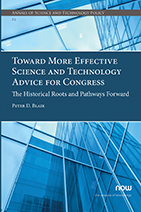Toward More Effective Science and Technology Advice for Congress: The Historical Roots and Pathways Forward
By Peter D. Blair, George Mason University, Schar School of Policy and Government, USA, pblair2@gmu.edu
Abstract
Science and technology (S&T) assessment designed to effectively inform Congress must be both credible and suitable to congressional needs. To be unimpeachably credible, it should be widely accepted as (1) authoritative, (2) objective, and (3) independent. To be suitable and well-matched to congressional needs, the advice must be (4) relevant, (5) useful, and (6) timely. For S&T advice today, Congress draws on many sources for advice but it created four organizations over the last century and a half to provide itself with different types S&T advice: (1) the National Research Council, the operating arm of the National Academies of Sciences, Engineering and Medicine, (2) the Congressional Research Service, (3) the former Office of Technology Assessment, and (4) the Government Accountability Office. This monograph traces the historical roots of S&T advice for Congress and chronicles the creation and evolution of these four organizations over the past half century. Key characteristics for providing effective S&T advice for Congress are defined and then used to evaluate the relative strengths and weaknesses of these organizations today and to identify prospective organizational improvements in each to meet today’s needs.
Toward More Effective Science and Technology Advice for Congress: The Historical Roots and Pathways Forward
Toward More Effective Science and Technology Advice for Congress traces the historical roots of science and technology advice for Congress and chronicles the creation and evolution of the four organizations that provided this advice over the past half century -- (1) the National Research Council, (2) the Congressional Research Service, (3) the former Office of Technology Assessment, and (4) the Government Accountability Office. Key characteristics for providing effective S&T advice for Congress are defined and then used to evaluate the relative strengths and weaknesses of these organizations today and to identify prospective organizational improvements in each to meet today’s needs.
